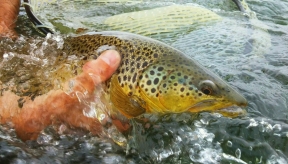
I’m more optimistic than I was last year at this time. Currently our snowpack ranges from slightly above normal on the Henry’s Fork drainage to considerably above normal on some of the other watersheds in our service area. As we learned last year, what happens with the weather in the spring is a major factor in what the stream flows will be like during the course of the season. Even though our snowpack was about normal last year, a warm dry March and early April changed the perspective very quickly. Our spring weather will always play a significant role in what happens in the summer. Like last year, our runoff started about 2 weeks ahead of normal. The good news is that unlike last year, the weather cooled back down and we’ve received ample moisture to keep from losing the snowpack so quickly.
It’s always very difficult to make streamflow predictions. I always take a close look at the current snowpack and then try to play weatherman by watching the spring weather trends. Other streams in the Upper Snake watershed also can have significant bearing on what to expect. With that in mind I have broken down all of the major fisheries in our service area. Currently all of the streams are running above normal for this time of year. This is partly because our runoff started early but we have also continued to receive moisture and near normal temperatures.
Henry's Fork
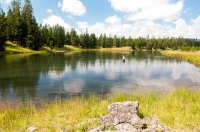
First off our reservoir storage is in good shape. Given current inflow predictions both Henry’s Lake and Island Park Reservoir should fill by May 1. Maintaining full reservoirs through May will require outflows of 100–150 cfs from Henry’s Lake and 800-1000 cfs from Island Park. Looking at June and beyond is a might trickier. If the weather doesn’t get too hot and dry, the flows could stay near May levels through June. If it gets hot and dry, my prediction is the outflow from Island Park will drop. Why will it drop you ask? Currently the snowpack in the Fall River and Teton Rivers, the two major tributaries of the Henry’s Fork, is currently about 125% of normal. How quickly this runoff comes off is highly dependent upon the weather conditions in May. If Fall River and the Teton are running high in June, the flow from Island Park will continue to match inflow. If the Upper Henry’s Fork runoff is over by mid-June the inflow could drop down to 500 - 700 cfs.
Fall River and the Teton River should provide enough natural flow to meet irrigation demand until early to mid-July. This would help keep the flows through the Box Canyon and the Ranch fairly stable, a welcome change from what we experienced last season.
South Fork
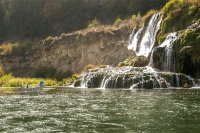
Right now Palisades Reservoir is 14% of capacity and the outflow is just under 20,000 cfs compared to a normal outflow of about 4000 cfs for the same date. It is estimated that the snowpack above Palisades is 3 times the capacity of the reservoir. For this reason the flush will continue to minimize flooding. The Palisades snowpack is comparable to 2011. Using the 2011 water year data might be the best way to predict what to expect for the 2017 season. With that in mind it is likely the flow from Palisades will continue at the current level until mid-July. Remembering that predicting the long-term weather is not an exact science, the flows from Palisades could deviate substantially. For example, in 2011 the flow was in excess of 23,000 cfs in early June. Later it dropped back to 15,000 cfs later in June only to ramp back up to over 23,000 cfs again in early July, not ideal for the July 4th weekend. I’m hopeful that since the BOR started releasing early to keep the reservoir capacity low that the flows will be more stable than in 2011. No matter what, we are planning on high water in the South Fork until mid-July or later.
Teton River
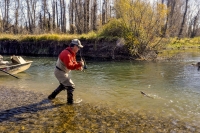
The Teton River is a true spring creek with a natural year-round flow of about 400 cfs. The upper section also carries the runoff from the snowpack in the Teton and Big Hole mountain ranges. Without reservoir storage the flow is totally dependent upon weather and snowpack. In 2011 the snowpack in these mountains was comparable to this year. Peak flows of over 2400 cfs were reached the first week of July. After that the flows decreased steadily until they stabilized at 400 cfs in early September. This year could be a repeat of 2011. What happens moving forward will be totally dependent on the weather. We expect the Teton to be high and off-color until early July.
Madison River
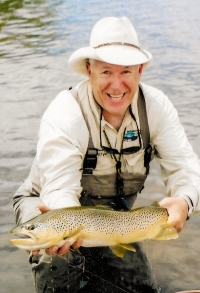
Last year was a good year on the Madison. With snowpack slightly above normal we anticipate a very good fishing year on the Madison. If the weather stays near normal the Madison below Quake Lake will likely be high and off-color until mid to late June. These conditions should be helpful with the salmonfly hatch anticipated to start near Ennis in late June moving up to the Reynolds Pass section by early July. After that look for good hatches of caddisflies, PMDs and Flavs.
Yellowstone Park
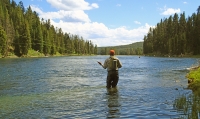
Like other watersheds, a good snowpack bodes well for the rivers and streams in the park. Early in the season the Madison and its two major tributaries the Firehole and Gibbon will be high and possibly a bit off-colored. However, fishing should hold up through mid-June into early July. Don’t expect to wade across the Yellowstone when it opens on July 15th. The higher water will likely help the stonefly hatches. The snowpack will also benefit other rivers like the Lamar and Slough Creek later in the season.
All in all I’m very optimistic for the upcoming 2017 season. I have total confidence that it will be much better than last year. Space doesn’t allow to get into specific hatches. We’ll be more specific with future blogs.